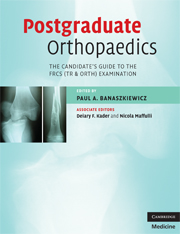Book contents
- Frontmatter
- Contents
- List of contributors
- Foreword by Mr Peter Gibson
- Preface
- Glossary
- Section 1 The FRCS (Tr & Orth) examination
- Section 2 The written paper
- Section 3 The clininicals
- Section 4 Adult elective orthopaedics oral
- Section 5 The hand oral
- Section 6 The paediatric oral
- Section 7 The trauma oral
- Section 8 The basic science oral
- 24 Basic science oral core topics
- Section 9 Miscellaneous topics
- Index
- References
24 - Basic science oral core topics
from Section 8 - The basic science oral
Published online by Cambridge University Press: 22 August 2009
- Frontmatter
- Contents
- List of contributors
- Foreword by Mr Peter Gibson
- Preface
- Glossary
- Section 1 The FRCS (Tr & Orth) examination
- Section 2 The written paper
- Section 3 The clininicals
- Section 4 Adult elective orthopaedics oral
- Section 5 The hand oral
- Section 6 The paediatric oral
- Section 7 The trauma oral
- Section 8 The basic science oral
- 24 Basic science oral core topics
- Section 9 Miscellaneous topics
- Index
- References
Summary
Introduction
The FRCS Orth examination will definitely test you on aspects of basic science – in the past there has commonly been a surgical approach question in the written paper, and although the format is changing it is highly likely that the emphasis and content of questions will not. Critical appraisal of a journal article will remain a part of the revised examination and will require a working knowledge of statistics.
The Basic Science Oral is often feared by candidates, but having established that there is no avoiding it, the key to understanding basic science in orthopaedics and to making it stick in your head is to keep it clinically relevant and to concentrate on understanding concepts rather than learning lists of esoteric facts.
The Basic Science section of the syllabus includes the following headings:
Anatomy
Tissues
Physiology, biochemistry and genetics
Biomechanics and bioengineering
Bone and joint diseases
Osteoarthritis
Osteoporosis
Metabolic bone diseases
Rheumatoid arthritis and other arthropathies (inflammatory, crystal, etc.)
Haemophilia
Inherited musculoskeletal disorders
Neuromuscular disorders – inherited and acquired
Osteonecrosis
Osteochrondritides
Heterotopic ossification
Bone and soft-tissue sarcomas
Metastases
Orthopaedic oncology
Investigations
Operative topics
Infection, thromboembolism and pain
Prosthetics and orthotics
Research and audit
Medical ethics
This section of the guide will take you through areas that are commonly tested from the above list. The content cannot be comprehensive; you should check through the above list after reading this chapter and identify areas of weakness in your knowledge that remain.
Anatomy will not be covered here as it is a topic well dealt with in other revision texts.
- Type
- Chapter
- Information
- Postgraduate OrthopaedicsThe Candidate's Guide to the FRCS (TR & Orth) Examination, pp. 461 - 566Publisher: Cambridge University PressPrint publication year: 2008



